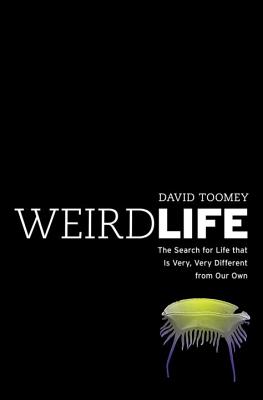by David Toomey
Look, I’m as geeky as the next girl. How can you hear the subject matter of this book and not be fascinated? David Toomey opens Weird Life exactly where I would expect—with extremophiles. Extremophiles are some of the most unusual and extraordinary creatures in all of biology. Which makes sense, because life = biology. Right?
That’s what I thought, but clearly that’s due to a massive failure of imagination on my part. One the most impressive things about Toomey’s book are the sheer breadth, depth, and scope of what is covered. Toomey starts with biology—microbiology, exobiology, marine biology, synthetic biology, molecular biology, astrobiology, evolutionary biology. That, friends, is the mere tip of the iceberg. Toomey touches on disciplines and theories including: organic chemistry, inorganic chemistry, interstellar chemistry, molecular chemistry, biochemistry, nuclear chemistry, geology, genetics, robotics, computer science, mathematics, theoretical physics, particle physics, quantum physics, astrophysics, string theory, nanotechnology, multiverses, astrology, botany, taxonomy, engineering, ecology, epistemology, psychology, and philosophy. If that’s not enough, there’s even a chapter on weird life in science fiction! This book is thorough, that’s all I’m saying. There’s a reason for this:
“The attentive reader may have noticed that ideas for the weirdest sorts of weird life did not originate with biologists or even, for that matter, with astrobiologists. They came from scholars and practitioners in other fields. The hypotheses of life in other universes were formulated by theoretical physicists (Harnik, Kribs, and Perez; and Jaffe, Jenkins, and Kimchi). Ideas of life in the vicinity of black holes and the atmospheres of white dwarf stars were conceived by astrophysicists (Adams and Laughlin). Hypotheses of life surviving through eternity were developed by a mathematician and theoretical physicist (Dyson), who also supplied us with what may be the broadest definition of life so far. Of the many ideas of weird organisms from science fiction, two that are notably well grounded in science are from a physicist turned aerospace engineer (Forward) and from a professional astronomer (Hoyle). Even the relatively conservative hypothesis of hydrogen-breathing dirigibles was proposed by a physicist (Saltpeter) and a planetary scientist turned astrobiologist (Sagan).”So… there’s some smart stuff in this book. Do not be intimidated! I’m incredibly uneducated, and I had no difficulty reading Weird Life from cover to cover. My mind was occasionally blown—but always in a good way. And if you need a little reminder on the difference between a mesophile and a methanogen, please be aware that there’s a glossary at the back of the book between the text and the endnotes, but before the very thorough bibliography.
This book covers science that is being done right up to the minute. At least three times a variation on the phrase “as we go to press” was used. This science is emergent and so very, very fascinating. Here’s a good example, arising from our lack of understanding of what comets are made of:
“Being mostly solid bodies, comets resist interferometry. In 2003, it occurred to Allamandola and his colleague Doug Hudgins that there was another way. If they could make a comet from scratch, they could study it. They took a sample chamber called a “cosmic ice simulation chamber,” removed most of its atmosphere, and froze what was left to a temperature near absolute zero, thus making the inside of the chamber a fair representation of deep space. They introduced into the chamber a few simple molecules that might be found in a star’s outflow, and turned on a lamp (representing nearby stars) that bathed the molecules in ultraviolet radiation. Then they waited. They were not expecting much, and they were certainly not expecting what happened. The molecules combined, split, and recombined, and before long the chamber contained some very complex molecules, many of which were prebiotic.”Is your mind blown? Maybe it’s just me. But I couldn’t put this book down. My only minor disappointment is that there weren’t more photos and illustrations, but I guess it’s hard to fault an author for not including images of hypothetical things that may or may not exist. Toomey did pretty well, all things considered.
Life, in all its colors and flavors, is amazing. Mr. Toomey has reminded me of that fact. This was the most enjoyable science book I have read in quite a few years. My mind and ideas have been expanded, quite painlessly. So let’s, as Mr. Toomey suggests, allow our imaginations free reign.


Thanks Susan, I'll be adding this one too. Love a good science book!
ReplyDelete